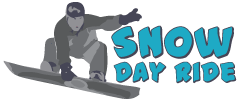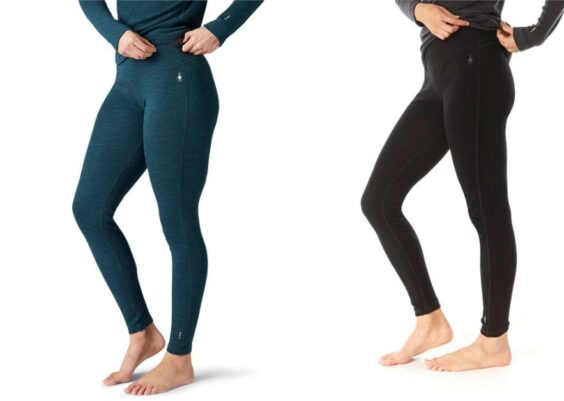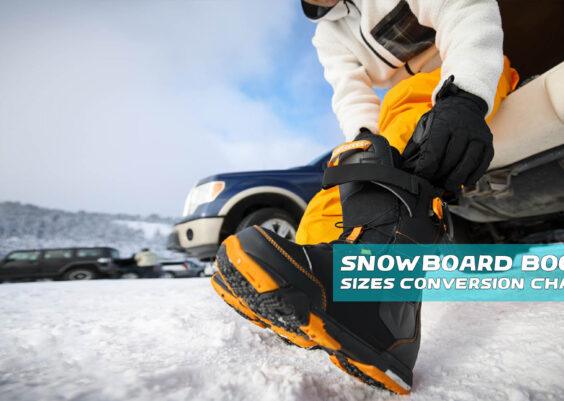Last updated on September 5th, 2025 at 02:22 pm
Key Takeaways
- Skiing is easier for beginners because of its natural stance and simple techniques.
- Snowboarding is harder at the start but smoother to progress once carving is learned.
- Skiing has fewer falls and less pain early on.
- Snowboarding often means more falls and higher injury risk in the beginning.
- Expert-level snowboarding is reached faster than expert-level skiing.
- Skiing costs a little more in gear but both sports are expensive.
- The best choice depends on which sport looks more fun to you.
Is snowboarding harder than skiing? Yes, for most beginners it is. Skiing feels more natural because you face forward and move with independent legs. You can control balance quickly, pick up the basic snowplow, and enjoy beginner runs on the first day.
The rest of this guide breaks down the differences so you can choose the one that fits you best.
Is Snowboarding Harder Than Skiing?
Yes, snowboarding is harder than skiing at the beginning. Skiing gives you a forward-facing stance that feels natural, with each leg working independently. That setup allows quick balance corrections and early success on beginner slopes. Most new skiers can learn the snowplow and link basic turns within a day.
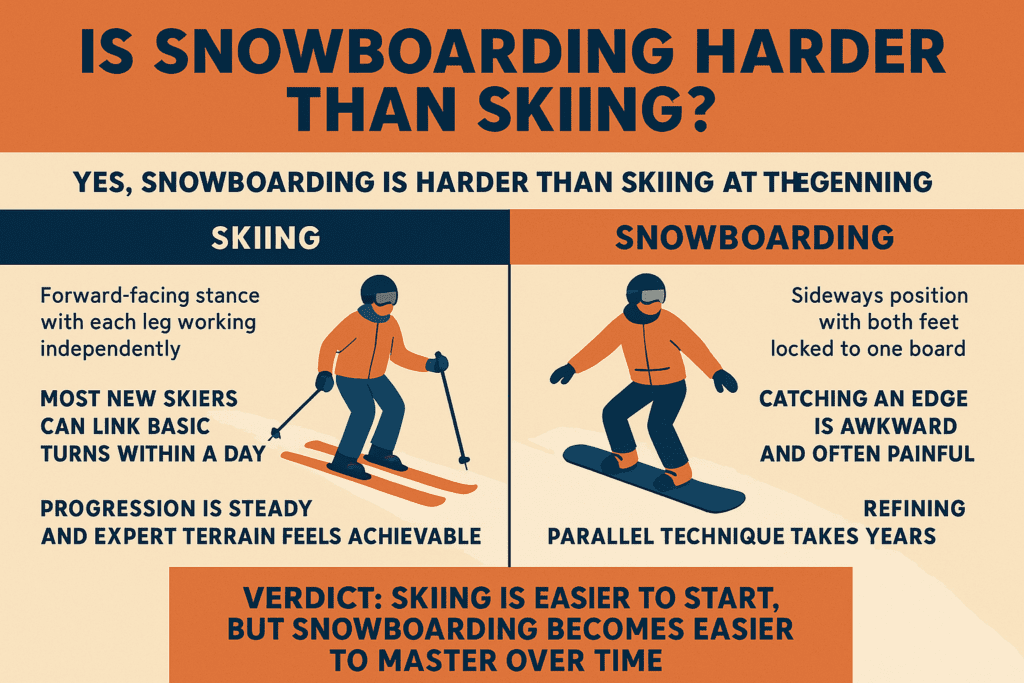
Snowboarding, by contrast, locks both feet to one board in a sideways position. Controlling heel and toe edges is awkward, and catching an edge often leads to painful falls. The first few days can be slow and discouraging. The trade-off comes later.
Once snowboarders master carving, progression is steady and expert terrain feels achievable more quickly. Skiers, meanwhile, face years of refining parallel technique. Verdict: skiing is easier to start, but snowboarding becomes easier to master over time.
Comparison Facts Between Snowboarding and Skis
Skiing and snowboarding may share the same slopes, but they feel very different once you clip in. The stance, the way you balance, and even how you fall all shape the learning process.
For beginners, these details matter more than anything else. To understand why skiing often feels easier at first while snowboarding challenges newcomers, let’s break down the main factors that set the two sports apart.
Stance and Body Position
The first thing beginners notice is how different skiing and snowboarding feel when standing still. Skiers face forward, with feet on separate skis. This position mirrors walking and gives each leg freedom to react to changes in balance. If one ski slips, the other can help recover quickly.
| Sport | Stance | Balance Control | Recovery Ability |
|---|---|---|---|
| Skiing | Forward-facing | Independent legs help | Easier to correct |
| Snowboarding | Sideways, feet locked | Heel and toe edge shifts | Harder to recover |
Snowboarding is less forgiving. Riders stand sideways with both feet strapped to a single board. This stance feels awkward at first, especially for those without skateboard or surf experience. With no independent leg movement, balance relies entirely on shifting weight between the heel and toe edges. The locked stance also makes falling more common and recovery harder.
Pro Tip: If you’ve skated or surfed before, snowboarding may feel more natural despite the tougher stance.
Learning Curve for Beginners
The learning curve is where skiing clearly pulls ahead for most beginners.
Skiers start with the snowplow, or “pizza,” where the ski tips point inward to control speed. This simple move gives new skiers immediate control and confidence on gentle slopes.
Turning is equally straightforward: press the inside edge of one ski to steer in the opposite direction. With a day of practice, most people can link turns and ride beginner trails without too many falls.
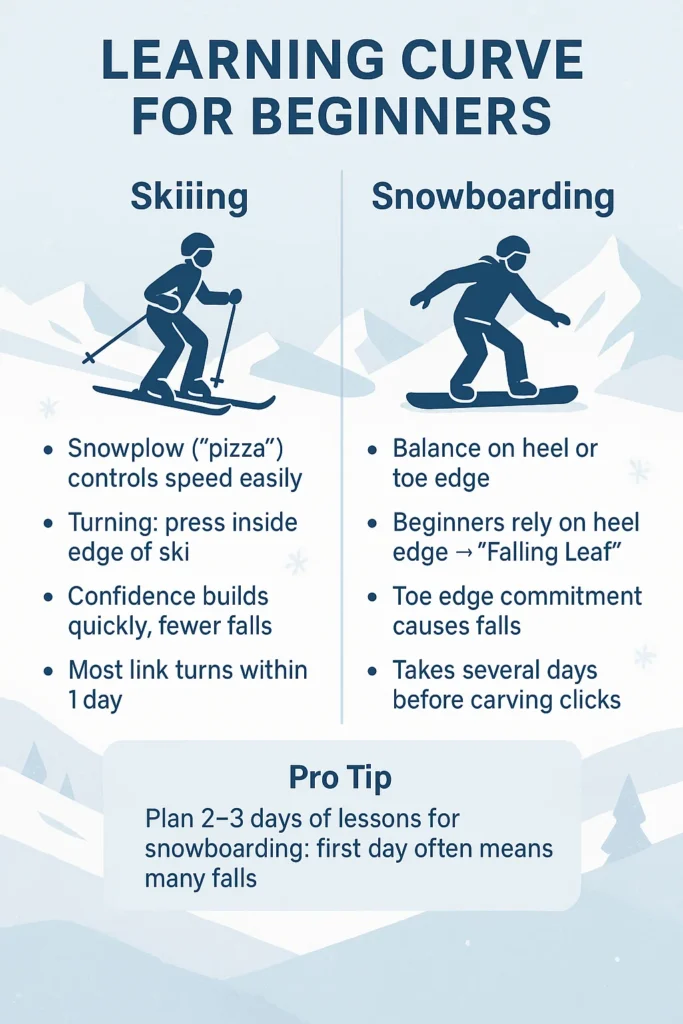
Snowboarding requires more patience. Progress starts with balancing on either the heel or toe edge. Beginners often rely heavily on the heel edge to avoid falling forward, which leads to the “Falling Leaf” method – sliding down the hill slowly without true turns.
The real challenge comes when committing to the toe edge. Many riders catch an edge, slam down, and lose confidence. This stage can last for days before carving finally “clicks.” Once that moment comes, progress speeds up, but the painful start discourages plenty of newcomers.
Pro Tip: Plan at least two to three days for snowboarding lessons, since the first day is often filled with falls.
Risk and Falling
Falling is part of every winter sport, but the type and frequency of falls differ between skiing and snowboarding. Skiers usually fall less often in the early stages because the forward stance allows quick recovery.
If balance shifts, one leg can correct while the other supports. Most ski falls happen at slower speeds and involve sliding to the side, which is less punishing.
| Sport | Fall Frequency | Common Impact Areas | Recovery Difficulty |
|---|---|---|---|
| Skiing | Lower | Side slides, knees, hips | Easier |
| Snowboarding | Higher | Wrists, back, tailbone, head | Harder |
Snowboarders, on the other hand, fall more often and usually with greater impact. With both feet locked to a single board, there’s no chance to step out for balance. When the board catches an edge, riders can slam backward onto their tailbone or head, or forward onto their wrists and chest.
These falls happen quickly and repeatedly during the first days, which is why protective gear, especially helmets and wrist guards is strongly recommended.
Pro Tip: Always wear a helmet for both sports, but snowboarders should add wrist guards to reduce injury risk.
Progression After the Basics
Once the beginner phase is over, the progression paths for skiing and snowboarding split.
Skiers often face a long technical road. The snowplow is useful early on but must be unlearned to handle steeper terrain. Parallel skiing becomes the goal, requiring strong edge control, proper body alignment, and years of practice. Even after mastering parallel turns, advanced slopes demand refined carving and precision that can take decades to perfect.
| Aspect | Skiing | Snowboarding |
|---|---|---|
| First Step Beyond Basics | Unlearn snowplow, start parallel turns | Learn consistent heel/toe carving |
| Key Challenge | Breaking habits and building form | Overcoming fear of toe-edge commitment |
| Time to Expert Terrain | Often 8–10+ years of refining technique | Often 3–5 years once carving is mastered |
| Long-Term Demand | Continuous focus on form and precision | Same edge skills apply across all levels |
Snowboarders have a smoother path once they learn to carve. The same heel and toe edge engagement applies across different terrains, from groomed runs to powder and even park features. Progression feels consistent, and many riders reach expert terrain in a shorter time compared to skiers. The early pain pays off with faster access to challenging slopes.
Pro Tip: If you want faster access to advanced slopes, snowboarding usually gets you there sooner.
Fun Factor and Style
Both skiing and snowboarding bring their own flavor of fun, but the style is very different. What feels exciting to one person may not appeal to another, so it’s worth looking at what each sport offers.
Skiing
- Precision: Skiers can make tight, controlled turns on steep terrain. This makes it easier to navigate icy patches, moguls, and narrow trails.
- Speed: Skis are built for velocity, and many people enjoy pushing for fast, downhill runs. The design allows better stability at high speeds compared to a snowboard.
- Versatility: Skiing adapts well to different terrains. From groomed slopes to moguls and powder, skis handle a wider range of conditions.
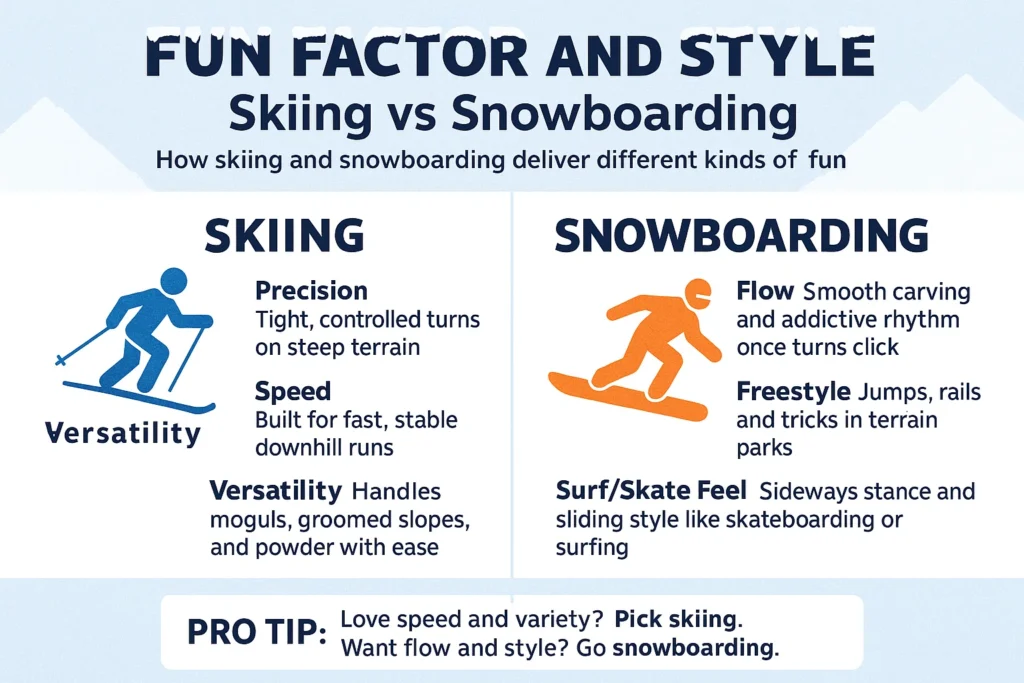
Snowboarding
- Flow: Once carving clicks, riding a snowboard feels smooth and fluid. Linking turns creates a rhythm that many describe as addictive.
- Freestyle: Snowboards thrive in terrain parks. Jumps, rails, and tricks are easier to approach compared to skis, giving the sport a playful edge.
- Surf/Skate Feel: Snowboarding shares movements with skateboarding and surfing. Riders often enjoy the sideways stance and sliding style that feels familiar if they’ve tried board sports before.
Pro Tip: If you love speed and variety, skiing fits better. If you want style and flow, snowboarding wins.
Fitness and Physical Demand
Both skiing and snowboarding are demanding, but they tax the body in different ways.
Skiing spreads the effort between both legs, with a strong focus on the quads, calves, and glutes. Beginners often feel burning legs after a few runs, especially when holding the snowplow stance.
Snowboarding works the core and stabilizer muscles more. Balancing on the heel and toe edges forces the abs, lower back, and hips to stay engaged at all times. The frequent falls and constant push-ups from the snow also add upper body fatigue.
| Sport | Primary Muscles Worked | Extra Demands | Beginner Fatigue Level |
|---|---|---|---|
| Skiing | Quads, calves, glutes | Knee stability, balance | Moderate (leg burn) |
| Snowboarding | Core, hips, stabilizers | Upper body from falls and push-ups | High (whole-body fatigue) |
For beginners, snowboarding usually feels more tiring. Falling, standing up repeatedly, and the awkward toe-edge balance drain energy fast. Skiing can be exhausting on the thighs, but most first-timers last longer on skis before fatigue sets in.
Pro Tip: If fitness is a concern, start with skiing. It’s easier to pace yourself and stay on the slopes longer.
Cost and Practical Considerations
Cost is a big factor when choosing between skiing and snowboarding. Both sports require expensive gear, lessons, and lift tickets, but skiing often ends up slightly pricier.
Skiers need two skis, boots, and poles, while snowboarders just need a board and boots. Rentals reflect that difference, with ski packages usually costing more per day. Lessons are priced about the same, though some resorts offer group packages that make skiing lessons more affordable.
| Expense/Factor | Skiing | Snowboarding |
|---|---|---|
| Gear Needed | Skis, boots, poles | Board, boots |
| Rental Cost | Higher (extra equipment) | Lower |
| Lesson Pricing | Similar (slight edge for group skiing) | Similar |
| Long-Term Cost | Ski gear usually more expensive | Slightly cheaper overall |
| Slope Navigation | Easier on flats with poles | Harder on flats, may need to walk |
Resorts generally provide equal access to slopes for both sports, but some terrain features, like narrow mogul runs, are easier for skiers. Snowboarders may spend more time walking on flat areas where skiers can use poles to push forward.
Pro Tip: If budget matters, snowboarding usually costs less, but skiing rentals often include better group lesson deals.
Snowboarding vs Skiing: Which One Should You Choose?
There is no universal winner between skiing and snowboarding. The right choice depends on what you want from the mountain.
Skiing is better for quick fun. Most beginners can pick it up in a single day, enjoy the slopes, and spend more time riding than falling.
Snowboarding is better for those who value challenge and style. The first few days are tough, but once carving clicks, the sport offers smooth flow and fast progression.
Here’s a side-by-side look:
| Factor | Skiing | Snowboarding | Winner |
|---|---|---|---|
| Ease for Beginners | Natural stance, quick to learn | Tough stance, slow start, painful falls | Skiing |
| Long-Term Progress | Technical, years to refine | Steady once carving is mastered | Snowboarding |
| Falls & Injuries | Fewer falls, easier recovery | Frequent falls, wrist/back/head risk | Skiing |
| Fun & Style | Precision, speed, versatility | Flow, freestyle, surf/skate feel | Snowboarding |
| Cost | Slightly higher (extra gear, rentals) | Slightly lower overall | Snowboarding |
| Best For | Casual fun, quick trips | Passionate riders, style seekers | Depends on rider |
Verdict: Choose skiing if you want fast success and casual fun. Pick snowboarding if you want a stylish sport with faster long-term progress.
FAQ: Skiing vs. Snowboarding
1. Is skiing safer than snowboarding for beginners?
Yes. Skiing has fewer falls since you face forward and use independent legs. Snowboarders fall more often, with higher risk of wrist and head injuries.
2. How long does it take to learn skiing vs snowboarding?
Most beginners ski down green slopes in a day. Snowboarding takes a few days to link turns, but progression is faster once carving clicks.
3. Which is more expensive: skiing or snowboarding?
Skiing costs slightly more because of extra gear. Rentals, lessons, and lift tickets are otherwise similar.
4. Is snowboarding more tiring than skiing?
Yes for beginners. Snowboarders burn energy falling and standing up, while skiing mainly tires the thighs.
5. Which sport is better for kids to start with?
Skiing is easier and less frustrating for kids. Snowboarding suits those with skate or surf experience.
6. Can I switch from skiing to snowboarding (or vice versa) easily?
Yes, but not instantly. Balance skills transfer, though stance and movement feel different at first.
Is snowboarding harder than skiing? Yes, especially in the beginning. Skiing feels natural and gives beginners quick wins, while snowboarding starts with more falls and frustration. But difficulty alone shouldn’t decide for you. Both sports bring unique excitemen. The right choice is the one that makes you eager to get back on the slope. Pick what excites you most, because the best sport is the one you’ll love riding again and again.
